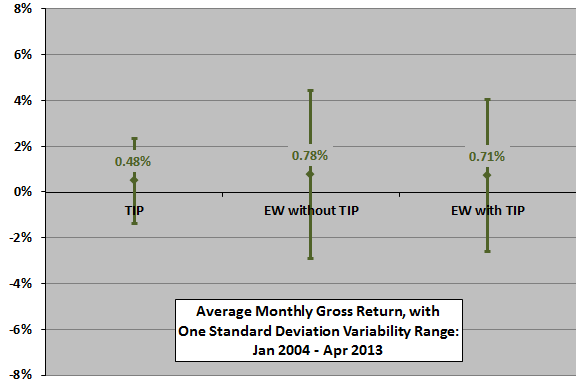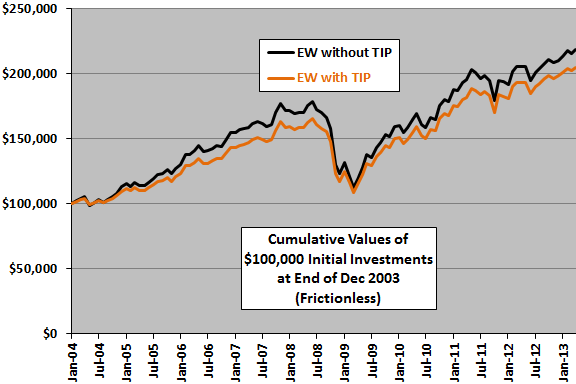Treasury Inflation-Protected Securities (TIPS), offering an explicit inflation hedge, may be an attractive asset for strategic diversification. To check, we add iShares Barclays TIPS Bond Fund (TIP) to the following mix of asset class proxies (the same used in “Simple Asset Class ETF Momentum Strategy”):
PowerShares DB Commodity Index Tracking (DBC)
iShares MSCI Emerging Markets Index (EEM)
iShares MSCI EAFE Index (EFA)
SPDR Gold Shares (GLD)
iShares Russell 1000 Index (IWB)
iShares Russell 2000 Index (IWM)
SPDR Dow Jones REIT (RWR)
iShares Barclays 20+ Year Treasury Bond (TLT)
3-month Treasury bills (Cash)
First, per the findings of “Asset Class Diversification Effectiveness Factors”, we measure the average monthly return for TIP and the average pairwise correlation of TIP monthly returns with the monthly returns of the above assets. Then, we compare cumulative returns and basic monthly return statistics for equally weighted (EW), monthly rebalanced portfolios with and without TIP. We ignore rebalancing frictions, which would be about the same for the alternative portfolios. Using adjusted monthly returns for TIP and the above nine asset class proxies as available from January 2004 (first available for TIP) through April 2013 (112 monthly returns), we find that:
The following chart summarizes average monthly returns with variability ranges of one standard deviation for TIP and the EW portfolios without and with TIP over the available sample period. During this time, TIP generates an average return comparable to that of EW without TIP with low volatility. Adding TIP to the diversified EW portfolio slightly reduces both return and volatility. The ratio of average return to standard deviation (return per unit of risk) is 0.21 (0.21) without (with) a TIP position.
The average pairwise correlation of TIP monthly returns with those of the other assets is below average 0.25 over the available sample period. Pairwise correlations are positive for eight of the nine other assets.
Per “Asset Class Diversification Effectiveness Factors,” the somewhat low average return and modestly below average pairwise correlation of TIP indicates a middling contribution with respect to portfolio diversification.
Sample size is not large in terms of a variety of market conditions and inflation regimes.
How do its return characteristics translate into cumulative value?

The next chart compares cumulative values of EW portfolios without and with TIP in the mix over the available sample period. Adding TIP hurts (helps) a little during equity bull (bear) markets, to a negative net effect.
Again, sample size is small in terms of market conditions and inflation regimes.

In summary, evidence from simple tests over the available sample period does not support belief that adding TIP to a diversified portfolio improves performance.
It may be that the diversification value of TIP emerges most clearly when inflation is more variable than recently.
Cautions regarding findings include:
- As noted, the sample period is very short in terms of market conditions (one bear market and fairly low inflation).
- Including the trading frictions associated with monthly rebalancing would depress performance of both portfolios, depending mostly on portfolio size.
See also “Real Value of TIPS for Investors” and “Do TIPS Work?”.